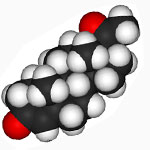| |
The human body has an amazing ability to protect itself from outside invaders and to repair itself after injury. For example, if you cut yourself, or if your body detects internal bacteria that shouldn’t be there, a series of responses from the immune system kick into gear. One of these mechanisms, known as inflammation, or the inflammatory response, allows for increased flow of fluid to the affected site. Why is this important? Because increased flow means more blood cells and proteins to fight off the invader or repair the injury. It also results in redness, pain, and swelling in the affected area. These symptoms are usually a temporary discomfort as your body fixes the problem and returns to normal.
But in the case of traumatic brain injury, such as a blow to the head, the inflammatory immune response that keeps you healthy can also prove deadly. Traumatic brain injury is caused by an external or mechanical force that affects the brain. Falling off your bike, skateboard or motorcycle and hitting your head on the ground, slamming into a windshield during a car crash, or getting hit in the head by a baseball are all examples of traumatic brain injury. Such events set off much the same inflammatory response in the brain as smashing your finger with a hammer would in your hand. But an excess of fluid in the brain is more dangerous, because unlike other parts of the body, this fluid has no other place to go. But it’s still best not to get the traumatic brain injury in the first place.
What Goes Wrong
Swelling of the brain, called cerebral edema, can cause neurons in the brain to die. As we get older, the neurons in our brains lose the ability to replicate themselves, so replacing dead neurons in your brain is very limited. If the swelling does not decrease quickly, you could lose too many neurons, resulting in a loss of brain function or brain death.
There are not many treatment options for patients with traumatic brain injury. The goal is to reduce cerebral edema as quickly as possible, but this is not always possible even if the patient gets immediate attention. There is no known way to regenerate brain cell growth. Some evidence suggests that neurons can be rewired to take over the function of lost brain cells, even in the adult brain. The key question is whether this can improve functional outcomes – and this is controversial, so the outlook for patients with traumatic brain injury is not very good.
Dr. Donald Stein has been studying traumatic brain injury for most of his career. In particular, he is interested in repair of the central nervous system, which includes the brain and spinal cord. He began his studies many years ago by observing the recoveries of animals, and later patients, with traumatic brain injury. Dr. Stein realized that there were a few clinical reports suggesting a difference between the extent and rate of recovery in men and women with traumatic brain injury. “At the time, no one really had systematically studied the effects of sex differences on traumatic brain injury and recovery in laboratory animals,” Dr. Stein remarked. “So that is what I set out to do.”
 ProgesteroneDr. Stein began his research with a rat model of traumatic brain injury, observing the recovery of male and female animals that had extensive parts of their frontal cortex removed. He noticed that female rats recovered remarkably better from this traumatic brain injury than did their male counterparts. It looked like the success of female recovery depended on the timing of the female rats’ estrus cycle. The estrus cycle is equivalent to the menstrual cycle in humans. As in the human menstrual cycle, there are two main hormones of the estrus cycle: progesterone and estrogen. Dr. Stein found that female rats did especially well when they were at the point in the cycle where they had high levels of progesterone relative to estrogen. These rats had less swelling, less brain damage, and less cell death than male rats or female rats that were at a different point in the estrus cycle. They also showed much better functional performance on a learning task designed to measure the severity of the injury. As a result of these early investigations, Dr. Stein began to look more carefully at the effects of progesterone on the brain. ProgesteroneDr. Stein began his research with a rat model of traumatic brain injury, observing the recovery of male and female animals that had extensive parts of their frontal cortex removed. He noticed that female rats recovered remarkably better from this traumatic brain injury than did their male counterparts. It looked like the success of female recovery depended on the timing of the female rats’ estrus cycle. The estrus cycle is equivalent to the menstrual cycle in humans. As in the human menstrual cycle, there are two main hormones of the estrus cycle: progesterone and estrogen. Dr. Stein found that female rats did especially well when they were at the point in the cycle where they had high levels of progesterone relative to estrogen. These rats had less swelling, less brain damage, and less cell death than male rats or female rats that were at a different point in the estrus cycle. They also showed much better functional performance on a learning task designed to measure the severity of the injury. As a result of these early investigations, Dr. Stein began to look more carefully at the effects of progesterone on the brain.
First Experiments
In his first experiments with progesterone in rats, Dr. Stein injected both males and females with progesterone one, six, twelve, twenty-four, and forty-eight hours after the initial brain trauma. As a control, Dr. Stein also injected a group of male and female rats with a saline solution that served as a control and would have no effect on the outcome. Dr. Stein found the male and female rats given the injections of progesterone had significantly less cerebral edema than the control group rats that received the saline injection. And male and female rats that had received the short course of progesterone treatment showed similar results. Dr. Stein also noted that, in addition to reducing brain swelling, progesterone appeared to help protect the damaged cells from dying off. Later on, other researchers found that the progesterone helped to reconstruct the myelin sheath, which surrounds all your neurons and allows them to conduct the electrical impulses that initiate and control your behaviors.
While cerebral edema is an important cause of damage in traumatic brain injury, the ultimate goal of any ‘neuroprotective treatment’ is not just to reduce the swelling but also to enhance the recovery of function after the injury. The next step in the research was to test how well the rats functioned on a variety of tasks after traumatic brain injury. Dr. Stein used a test called the Morris water maze, which examines an animal’s ability to locate an underwater platform by using visual and bodily cues. The rats are placed into a pool of water that contains a platform just below the surface. The rats swim around until they find the platform, which allows them to get out of the water. The researchers record how quickly rats are able to locate the platform and what strategies they used, including whether they remembered where they had already looked. Dr. Stein found that the rats that had been treated with progesterone performed much better on this test than the control rats given just saline. These were very promising results. In later experiments, Dr. Stein also determined that progesterone could be effective when treatment was delayed by as much as 24 hours after the initial injury. This is important because not everyone with a brain injury can receive very early treatment, so a drug with a good ‘window of opportunity’ for use is an important consideration.
Once Dr. Stein had determined that progesterone did have beneficial effects on the outcomes of the rats with traumatic brain injury, the next step was to test the efficacy of progesterone in human patients. At Emory University, Dr. Stein collaborated in a first-of-its-kind clinical study, with Drs. David Wright, Arthur Kellermann and other physicians, nurses and statisticians who examined 100 patients with moderate to severe traumatic brain injury. Patients were divided into 2 groups: one group was injected intravenously with progesterone for three days beginning six to eight hours after the injury; and a control, group was given state-of-the-art care but no progesterone. The mortality rate of the control group was 30.4%, compared to 13.7% in patients treated with the progesterone. The clinicians then tested the ability of patients to function after recovery using a well-known neurological rating system called the Disability Rating Scale. This scale measures a patient’s ability to speak, recognize objects or other people, take care of their basic needs, and perform simple motor tasks. (If you would like to see the actual DRS Form, click here, from the Center for Outcome Measurement in Brain Injury.) The doctors found that patients in the moderate brain injury group who were treated with progesterone had much better Disability Rating Scale scores than those given saline injections. “These are exciting results,” said Dr. Stein, “but there is still so much more to be done. This study only focused on 100 patients at one hospital.” The Emory doctors are planning to conduct a much larger, multi-center study in the near future.
Other Progesterone Uses
While this clinical work goes forward, Dr. Stein is also investigating other applications for progesterone in the laboratory. Dr. Stein has begun experiments in rats to determine the effects of progesterone on the brain after an ischemic stroke, which cuts off oxygen to parts of the brain by constricting the blood vessels. Stroke is different in some ways from traumatic brain injury, which is caused by an external force, because a stroke is an internal trauma that does not typically cause the stretching and tearing of neurons that happens after a traumatic brain injury. Nevertheless, Dr. Stein expects that many of the mechanisms of progesterone’s action are very similar in stroke and trauma. If his work is successful, it could help to revolutionize emergency medicine both at home and abroad. Progesterone could be administered on-site by ambulance or other medical personnel before the patient even reaches the hospital. Progesterone could also be brought to the battlefield where traumatic brain injuries are very common. To do this, progesterone would have to be developed into a more stable form such as an injection pen, tablet or pill, another area of Dr. Stein’s research.
Dr. Donald Stein is a neuroscientist and the Asa G. Candler Professor of Emergency Medicine at the Emory University School of Medicine. Although admittedly never that good at math, Dr. Stein was always interested in biology and history. “The historical background to research is very important,” Dr. Stein said. “I always make my students learn about the history of the subject before beginning their own experiments so that they can take advantage of the accumulated work and wisdom of others and be sure to acknowledge those scientists who have preceded them.” Aside from teaching and doing research, which he loves, Dr. Stein enjoys painting and traveling. He is also an avid bicyclist, skier, and tennis player. Dr. Stein encourages anyone interested in the world around them to pursue science as a career. He emphasizes our country’s need for more young scientists and especially wants to thank all of the graduate students, high school volunteers, and other staff who made this research possible.
To Learn More:
- Stein, D.
“Sex differences in brain damage and recovery of function: experimental and clinical findings” Progress in Brain Research 2007(161).
- Stein, D., D. Wright, and A. Kellermann
“Does Progesterone Have Neuroprotective Properties?” Annals of Emergency Medicine 2008(51): 164-172.
For More Information:
Written by Rebecca Kranz with Andrea
Gwosdow, Ph.D. Gwosdow
Associates
HOME | ABOUT | ARCHIVES | TEACHERS | LINKS | CONTACT
All content on this site is © Massachusetts
Society for Medical Research or others. Please read our copyright
statement — it is important. |
|
|

Dr. Donald Stein
 Helmet Testing Helmet Testing

Video courtesy of the Snell Memorial Foundation
Sign Up for our Monthly Announcement!
...or  subscribe to all of our stories! subscribe to all of our stories!

What A Year! is a project of the Massachusetts
Society for Medical Research.
|
|

